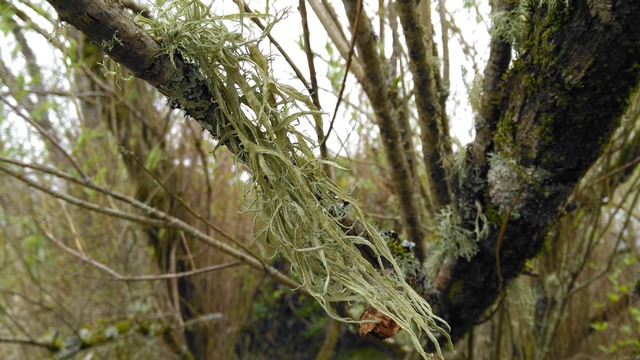Fruticose, bush-like Group
Introduction to the Fruticose Group
Their shrubby or bush-like, structure is attached at a single point and the thallus is pendulous or stands up away from the substrate.
The thallus structure is symmetrical with an outer cortex over the inner algal layer. Usnea, the beard lichen, has radially symmetrical fibres and a supporting central core. Ramalina is symmetrical across the thickness of its lobes and there is no difference between the upper and lower surfaces.
Usnea subfloridana, Beard lichen

This particularly well grown Usnea is 22cm long.
Ramalina calicaris

Grey-green thallus with edges turned up (canaliculate). Apothecia slightly fawn coloured.
Dobson says mostly found on a basic bark like willow and that this is a declining species
Ramalina fraxinea ?

This fine specimen, which is 17cm long, illustrates why Ramalinas are sometimes referred to as gristle or strap lichens. This specimen does not, however, comply totally with the desciription given by Dobson (2011 p386)
It has thongs that are just 2-4mm wide. Often bifurcated at tips.
Chemical test K- and C-.
Specimen fits several aspects of Arlectoria desciption given by Dobson (2011 p62)
Alectoria sarmentosa subsp. vexillifera maybe and not R. fraxinea?

Doubts over identification as a Ramalina: (A) Specimen is not reticulate. There should be a network of creases which requires both transverse and longitudinal features, transverse are not present.
(B)There are many, pale swellings just beneath the cortex that are 200-700 microns long and 100 microns wide, arranged longitudinally. (Pseudocyphellae?)
(C) Only a very few apothecia present but should be plentiful. See Clair Dalby illustration of R. fraxinea, plate 4 given by Richardson Pollution monitoring.
Ramalina fastigiata

A short and upright thallus covered with apical apothecia. Commom on nutrient rich bark
Evernia prunastri, Foliose Group

As the algal layer is only under the upper cortex it is foliose but included here to allow comparison with the superficially similar Ramalinas.
Test with potassium hydroxide solution indicates yellow and this differentiates it from the Ramalinas.
Known as “oak moss”, it has been used as a fixative for perfume, as a dyeing agent, ground up to make hair powder and as a wadding for shotguns. Also favoured by long tailed tits for nesting.
